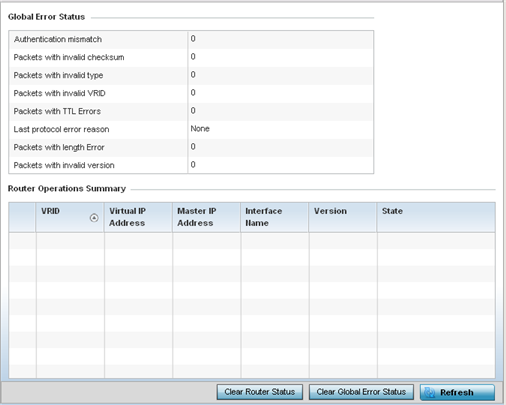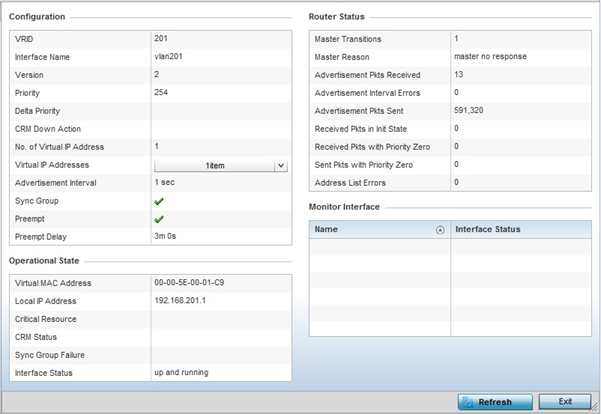VRRP
The VRRP statistics screen displays VRRP (Virtual Router Redundancy Protocol) configuration statistics supporting router redundancy in a wireless network requiring high availability.
To review a selected controller or service platform's VRRP statistics:
- Select the Statistics menu from the Web UI.
- Expand the RF Domain node.
- Select a Wireless Controller.
- Select VRRP from the
controller statistics menu.
The screen displays in the right-hand pane.

Refer to the Global Error Status field to review the various sources of packet errors logged during the implementation of the virtual route.
Errors include the mismatch of authentication credentials, invalid packet checksums, invalid packet types, invalid virtual route IDs, TTL errors, packet length errors and invalid (non matching) VRRP versions.
Refer to the Router Operations Summary area for the following status:VRID Lists a numerical index (1 - 254) used to differentiate VRRP configurations. The index is assigned when a VRRP configuration is initially defined. This ID identifies the virtual router a packet is reporting status for. Virtual IP Address Lists the virtual interface IP address used as the redundant gateway address for the virtual route. Master IP Address Displays the IP address of the elected VRRP master. A VRRP master (once elected) responds to ARP requests, forwards packets with a destination link layer MAC address equal to the virtual router MAC address, rejects packets addressed to the IP address associated with the virtual router and accepts packets addressed to the IP address associated with the virtual router. Interface Name Displays the interfaces selected to supply VRRP redundancy failover support. Version Display VRRP version 3 (RFC 5798) or 2 (RFC 3768) as selected to set the router redundancy. Version 3 supports sub-second (centisecond) VRRP failover and support services over virtual IP. State Displays the current state of each listed virtual router ID. - Optionally select a VRID to list the ID‘s VRRP
information in greater detail.

The Configuration area displays the following information:
VRID Lists this selected ID‘s assigned ID. The index is assigned when a VRRP configuration is initially defined. This ID identifies the virtual router a packet is reporting status for. Interface Displays the interfaces selected to supply VRRP redundancy failover support. Version Displays the VRRP version scheme used with the configuration. VRRP version 3 (RFC 5798) and 2 (RFC 3768) are selectable to set the router redundancy. Version 3 supports sub-second (centisecond) VRRP failover and support services over virtual IP. For more information on the VRRP protocol specifications (available publicly) refer to http://www.ietf.org/rfc/rfc3768.txt (version 2) and http://www.ietf.org/rfc/rfc5798.txt (version 3). Priority Lists the ID‘s numerical value (from 1 - 254) used for the virtual router master election process. The higher the numerical value, the higher the priority in the election process. Delta Priority Displays the configured priority (by the set value) when the monitored interface is down. When critical resource monitoring, the configured value is incremented by the value defined. CRM Down Action Lists the critical resource down action applied to this listed VRID. No. of Virtual IP Address Lists the number of virtual interface IP address used as the redundant gateway address for the virtual route. Virtual IP Addresses Lists the virtual interface IP address set as the redundant gateway address for the virtual route. Advertisement Interval Lists the interval for unsolicited router assignments. The advertisement interval is the minimum interval between sending router updates. Sending too many updates creates flapping of routes leading to possible disruption. Sync Group Lists whether a VRRP sync group is assigned to this VRRP ID‘s group of virtual IP addresses. This triggers VRRP failover if an advertisement is not received from the virtual masters that are part of this VRRP sync group. Preempt Lists whether preempt is enabled for the selected ID. Preempt ensures a high priority backup router is available to preempt a lower priority backup router resource. The default setting is enabled. When selected, the preempt delay option becomes enabled to set the actual delay interval for preemption. This setting determines if a node with a higher priority can take over all the Virtual IPs from the nodes with a lower priority. Preempt Delay If preempt is enabled, this item lists the delay interval (in seconds) for preemption. The Operation State area displays the following information:Virtual MAC Address Lists the alpha numeric virtual MAC address utilized by the selected VRID. Local IP Address This address represents an alternative to an interface IP address. The last byte of the address (XX) is the VRID, which is different for each virtual router in the network. Critical Resource Displays the critical resource currently utilized by the selected VRID. CRM Status Lists operational network status of the critical resource used by this VRID. Sync Group Failure Lists any sync failures detected with the sync group of virtual IP addresses. Interface Status Lists the operational network status of the interfaces selected to supply VRRP redundancy failover support. The Router Status area displays the following information:Master Transitions Lists the number of transitions to master router designation that have occurred with this VRID‘s router. Master Reason Displays an event message in respect the dedicated VRRP router‘s availability. Advertisement Pkts Received Lists the number of router advertisements received by this selected VRID. Router advertisements are periodically sent to hosts or sent in response to solicitation requests. Router advertisements contain prefixes used for link determination, address configuration and maximum hop limits. Advertisement Interval Errors Lists this VRID‘s number of advertisement prefix errors for link determination, address configuration and maximum hop limits. Advertisement Pkts Sent Lists the number of router advertisements sent by this selected VRID. Router advertisements are periodically sent to hosts or sent in response to solicitation requests. Router advertisements contain prefixes used for link determination, address configuration and maximum hop limits. Received Pkts in Init State Lists the number of packets received by the selected VRID when a router receives a hello packet but the local router ID is not listed in the received neighbor field. This means bidirectional communication is not been established. Received Pkts with Priority Zero Lists this VRID‘s number of received packets with a value of zero. Sent Pkts with Priority Zero Lists this VRID‘s number of sent packets with a value of zero. Address List Errors Lists the number of router event errors detected where an address that could not be resolved and bidirectional communication could not be established. - Refer to the Monitor Interface field to assess the names of this VRID‘s interface utilization and their respective statuses.
- Select Clear Router Status to clear the Router Operations Summary table values to zero and begin new data collections.
- Select Clear Global Error Status to clear the Global Error Status table values to zero and begin new data collections.
- Select Refresh to update the screen's statistics counters to their latest values.



